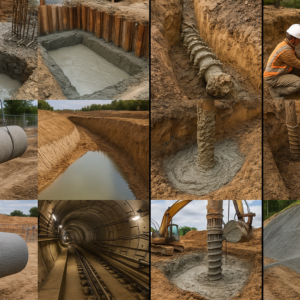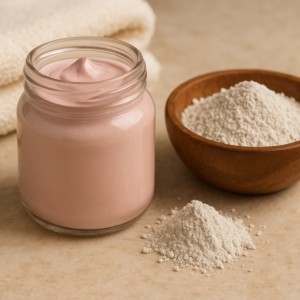Bentonite clay serves dozens of industrial applications, but not all bentonite is created equal. Each grade is processed and refined for specific uses, with unique chemical properties and performance characteristics. Paper bentonite stands apart from drilling, foundry, and construction grades in composition, particle size, and functionality.
Understanding these differences helps manufacturers select the right bentonite for their processes. Let’s break down what makes paper bentonite distinct and how it compares to other commercial grades.
Understanding Bentonite: The Foundation
Bentonite forms from volcanic ash that has weathered over millions of years. The resulting clay consists primarily of montmorillonite, a mineral with remarkable swelling properties. When bentonite contacts water, it can absorb up to 10 times its weight, creating a gel-like substance.
This swelling capacity drives bentonite’s value across industries. The degree of swelling, however, varies based on whether the bentonite is sodium-based or calcium-based. Sodium bentonite swells more than calcium bentonite, making it preferable for most industrial applications.
CMS Industries manufactures multiple grades of bentonite powder and lumps, producing over 9,000 metric tons monthly. The company sources material from mines across Kutch, Gujarat, processing it into specialized grades for different sectors.
What Makes Paper Bentonite Special?
Paper bentonite is engineered specifically for the pulp and paper industry. It functions as a retention aid, helping fine particles and fibers bond to the paper sheet during production.
Here is why paper-grade bentonite differs from other types:
- High Cation Exchange Capacity: Paper bentonite possesses superior ion-exchange properties. This characteristic allows it to attract and hold positively charged particles, improving retention of fillers and pigments during papermaking.
- Extreme Purity Standards: Paper applications demand bentonite with minimal iron content and other impurities. Discoloration or contamination affects the final product’s brightness and quality. Paper-grade bentonite undergoes rigorous purification to meet these strict requirements.
- Fine Particle Size: The material is milled to extremely fine particles, creating a large surface area. This maximizes contact with paper fibers and coating materials, improving bonding and retention rates.
- Optimized pH Levels: Paper bentonite maintains specific pH ranges compatible with paper production chemistry. This ensures it works effectively with other additives without disrupting the papermaking process.
Paper mills use this specialized bentonite in two ways. First, it works as a retention agent in the wet end of paper machines, binding fillers like calcium carbonate to cellulose fibers. Second, it functions as a coating agent, improving ink absorbency, print sharpness, and color reproduction on finished paper.
Drilling Grade Bentonite: Built for Borehole Stability
Drilling-grade bentonite serves the oil, gas, and water well industries. It creates drilling mud that stabilizes boreholes, cools drill bits, and carries rock cuttings to the surface.
Here are the defining features of drilling bentonite:
- Viscosity Requirements: Drilling bentonite must create thick, viscous mud when mixed with water. This viscosity suspends drill cuttings and prevents them from settling at the bottom of the borehole. The American Petroleum Institute sets standards for drilling-grade bentonite, specifying minimum viscosity levels.
- Gel Strength: The material needs to form a gel structure when at rest, holding cuttings in suspension even when pumping stops. When drilling resumes, the gel must break down easily and return to a flowing state.
- Filtration Control: Drilling bentonite forms a thin, impermeable filter cake on borehole walls. This cake prevents drilling fluid from seeping into surrounding rock formations, maintaining pressure control and preventing blowouts.
- Swelling Properties: High swelling capacity allows drilling bentonite to seal fractures and porous zones in the borehole wall. This prevents fluid loss and stabilizes the hole during drilling operations.
The key difference? Paper bentonite prioritizes purity and fine particle size for retention applications. Drilling bentonite focuses on rheological properties like viscosity, gel strength, and filtration control to maintain borehole integrity.
Foundry Grade Bentonite: The Binding Agent
Metal casting operations use foundry-grade bentonite as a binder in sand molds. The bentonite holds sand grains together, creating molds that can withstand molten metal pouring.
Foundry bentonite differs in these ways:
- Green Strength: This measures the mold’s ability to hold its shape before metal is poured. Foundry bentonite must provide adequate green strength so molds don’t collapse or deform during handling.
- Dry Strength: After molding, sand molds are dried or heated. The bentonite must maintain bonding strength even after moisture removal, keeping the mold intact until metal is poured.
- Hot Strength: When molten metal fills the mold, temperatures soar. Foundry bentonite must withstand this heat without breaking down, maintaining mold integrity until the metal solidifies.
- Moisture Sensitivity: The amount of water mixed with foundry bentonite affects mold properties. This grade is formulated to perform consistently across varying moisture levels.
Foundry bentonite typically contains both sodium and calcium bentonite blends. The ratio depends on the specific casting application and metal type. Iron foundries often use sodium bentonite, while non-ferrous casting may require calcium bentonite or specialized blends.
Unlike paper bentonite’s focus on purity, foundry grades prioritize mechanical strength and thermal stability. The material must survive extreme temperatures that would destroy paper-grade bentonite’s delicate structure.
Construction and Civil Engineering Grades
Construction-grade bentonite serves applications like slurry walls, waterproofing, and soil stabilization. This category includes several specialized types.
Geosynthetic Clay Liner (GCL) Grade: These bentonite sheets provide environmental barriers in landfills and containment systems. When hydrated, the bentonite swells to create an impermeable seal.
Grouting Grade: Used to seal soil around underground structures, grouting bentonite fills voids and creates waterproof barriers. It must maintain pumpability while still providing sealing properties.
Piling Grade: During pile foundation construction, bentonite slurry stabilizes boreholes in loose soil. The slurry prevents cave-ins while allowing pile insertion.
Construction bentonites need high swelling capacity to form effective seals and barriers. They don’t require the purity of paper-grade material since discoloration isn’t a concern. Performance under pressure and long-term stability matter more than aesthetic properties.
CMS Industries, an ISO 9001:2015 certified manufacturer, produces various bentonite grades from strategically located facilities near Mundra and Kandla ports in Gujarat. This positioning allows efficient export of construction and industrial-grade bentonites worldwide.
Cat Litter and Absorbent Grades
Consumer products use bentonite for its absorbent properties. Cat litter represents the most common household application.
Cat litter bentonite absorbs moisture and forms clumps that can be easily removed. The material must be dust-free to protect pet and human respiratory health. Odor control additives are often mixed with the bentonite.
These absorbent grades don’t face the stringent purity requirements of paper bentonite. Cost-effectiveness matters more since consumer products compete on price. The material is processed to create the right particle size for clumping without excessive dust generation.
Key Chemical and Physical Differences
The paper bentonite vs other grades of bentonite comparison comes down to several technical factors:
- Montmorillonite Content: Paper-grade bentonite contains the highest percentage of pure montmorillonite, often exceeding 90%. Other grades may have lower montmorillonite content with more impurities.
- Particle Size Distribution: Paper bentonite is milled to micron-sized particles. Drilling and foundry grades use coarser particles that don’t need the same level of refinement.
- Chemical Treatment: Some grades undergo sodium activation, where soda ash is added to convert calcium bentonite to sodium bentonite. Paper-grade material often starts with naturally occurring high-sodium bentonite to avoid chemical residues.
- Moisture Content: Each grade has specific moisture targets. Paper bentonite is dried to lower moisture levels than drilling grades, which can tolerate higher moisture content.
- Quality Control Standards: Paper bentonite faces the most rigorous testing for brightness, iron content, and purity. Drilling grades must meet API specifications for viscosity and filtration. Foundry grades are tested against VDG standards for strength properties.
Selecting the Right Bentonite Grade
Choosing between paper bentonite and other grades depends entirely on your application requirements.
Ask these questions:
- What properties matter most? If purity and retention are priorities, paper-grade bentonite is the answer. If viscosity and gel strength drive performance, drilling grade works better.
- What environmental conditions exist? Paper bentonite works in controlled papermaking environments. Drilling and foundry grades must perform in harsh conditions with temperature extremes and chemical exposure.
- What budget constraints apply? Paper-grade bentonite costs more due to processing requirements. Construction and foundry grades offer more economical options for applications where purity matters less.
- What regulatory standards must you meet? Different industries have different testing protocols and specifications.
Working with experienced bentonite suppliers helps match the right grade to your needs. Quality manufacturers can provide detailed specifications and even custom-blend bentonites for specialized applications.
Curious about how bentonite helps in papermaking? Read this blog to learn what paper bentonite is and why it’s essential for quality paper!
How Processing Creates Different Grades
The journey from raw bentonite ore to finished product varies by grade. Understanding this processing helps explain the price and performance differences.
Raw bentonite is quarried from deposits where volcanic ash altered into clay over geological time. After extraction, the material is dried to around 15% moisture content.
For paper-grade bentonite:
- The clay undergoes intensive washing to remove impurities
- Centrifugation separates fine particles from coarse ones
- Bleaching may be applied to improve brightness
- Ultra-fine milling creates the desired particle size
- Final drying reaches target moisture levels
- Quality testing ensures specification compliance
For drilling-grade bentonite:
- The raw material is crushed to manageable sizes
- Sodium activation with soda ash converts calcium to sodium bentonite
- Drying removes excess moisture
- Grinding creates the target particle size range
- Blending ensures consistent viscosity properties
- API testing confirms drilling fluid performance
Foundry and construction grades follow similar but less intensive processes. They don’t require the extreme purity or fine particle size of paper bentonite, reducing processing costs.
Industry Applications: Where Each Grade Shines
Paper-grade bentonite applications include:
- Copy and printing paper production
- Tissue and towel manufacturing
- Specialty paper coating
- Carbonless copy paper
- Wastewater treatment in paper mills
Drilling-grade bentonite serves:
- Oil and gas well drilling
- Water well construction
- Geotechnical drilling
- Horizontal directional drilling
- Environmental drilling projects
Foundry-grade bentonite supports:
- Iron and steel casting
- Aluminum casting
- Brass and bronze casting
- Investment casting
- Continuous casting operations
Construction-grade bentonite enables:
- Slurry wall construction
- Underground waterproofing
- Tunnel boring
- Dam and levee sealing
- Pond and lagoon sealing
Each application demands specific bentonite properties. Substituting one grade for another rarely works because the material won’t perform as designed.
Quality Assurance and Testing Standards
Different bentonite grades face different testing protocols.
Paper-grade bentonite testing includes:
- Brightness measurements
- Iron and heavy metal content
- Particle size distribution
- pH levels
- Cation exchange capacity
- Moisture content
Drilling-grade bentonite testing covers:
- Viscosity at standard concentrations
- Gel strength measurements
- Filtration rate and cake thickness
- pH and alkalinity
- Yield (barrels per ton)
- Sand and grit content
Foundry-grade bentonite evaluation examines:
- Green compression strength
- Dry compression strength
- Moisture content
- Permeability
- Flowability
- Durability
These testing differences reflect what matters in each application. Paper mills care about purity and brightness. Drilling operations need viscosity and filtration control. Foundries require strength and thermal stability.
Environmental and Sustainability Considerations
Bentonite production impacts vary by grade and processing intensity.
Paper-grade bentonite requires more processing, using more energy and water for purification. The environmental footprint is larger than for less-refined grades. However, bentonite itself is a natural material that’s generally safe and non-toxic.
Drilling-grade bentonite mixed with water creates a biodegradable drilling fluid. After use, the material can often be recycled or disposed of with minimal environmental impact. Some regions regulate drilling mud disposal to protect groundwater.
Foundry bentonite can be reclaimed and reused multiple times. Foundries typically recycle sand and bentonite binders, reducing waste. The material eventually degrades and must be replaced, but reuse extends its service life.
Construction-grade bentonite, particularly in waterproofing applications, provides long-term environmental protection by preventing contamination leaks and groundwater intrusion.
CMS Industries operates ISO 9001:2015 certified facilities that prioritize quality management systems. This certification ensures consistent production practices and quality control across all bentonite grades manufactured.
Wondering why sodium bentonite outperforms calcium bentonite in construction? Read this blog to find out which one delivers better results!
Cost Analysis: Investment vs. Performance
Paper-grade bentonite commands premium pricing due to:
- Extensive processing requirements
- Strict purity standards
- Lower production volumes compared to drilling grades
- Specialized quality testing
Drilling-grade bentonite costs less because:
- Processing is simpler
- Purity requirements are lower
- Production volumes are higher
- Testing is standardized but less intensive
Foundry and construction grades fall in the middle. They’re less expensive than paper grade but more costly than basic absorbent grades used in cat litter.
The cost difference makes sense when you consider application value. Paper manufacturers pay more for bentonite that improves retention and reduces fiber loss. The investment returns through better paper quality and reduced raw material waste.
Drilling operations save money by using less-refined bentonite that still provides required performance. The lower cost doesn’t compromise safety or effectiveness in borehole applications.
Future Trends in Bentonite Processing
Bentonite technology continues advancing across all grades.
Research focuses on:
- Reducing processing energy consumption
- Developing more environmentally friendly activation methods
- Creating bentonite blends that combine benefits from multiple grades
- Improving performance in extreme conditions
- Developing testing methods that better predict real-world performance
Paper-grade bentonite may see developments in:
- Bio-based activation methods replacing chemical treatments
- Nano-particle engineering for better retention at lower doses
- Combined retention and drainage improvement systems
- Reduced environmental impact in processing
These advances will likely narrow some performance gaps between grades while maintaining the specialized characteristics that make each grade suitable for its intended applications.
Making the Right Choice for Your Operations
The paper bentonite vs other grades of bentonite question doesn’t have a universal answer. Your choice depends on application requirements, performance needs, and budget.
Paper bentonite delivers unmatched purity and retention properties for papermaking. The premium cost reflects intensive processing and strict quality standards. If your process demands high-purity clay with excellent particle retention, paper grade is the only suitable choice.
Drilling, foundry, and construction applications need different properties where high purity doesn’t matter. These grades optimize viscosity, strength, or sealing capacity instead. Using paper-grade bentonite in these applications wastes money without improving performance.
Understanding what makes each grade unique helps you specify the right material. Work with knowledgeable suppliers who can explain technical specifications and recommend appropriate grades for your needs.
Ready to source the right bentonite grade for your application? Connect with CMS Industries for expert guidance on selecting from their range of specialized bentonite products. Their technical team can help match your requirements to the optimal bentonite grade, ensuring performance and cost-effectiveness.
Frequently Asked Questions
Q1: Can paper bentonite be used in drilling applications?
A: While technically possible, paper bentonite isn’t recommended for drilling. It’s over-engineered for that purpose, making it unnecessarily expensive. Drilling-grade bentonite provides the viscosity and filtration properties needed at a lower cost. Paper bentonite’s high purity and fine particle size offer no drilling advantages. Save money by using the grade designed for your specific application.
Q2: What testing should I request when buying paper-grade bentonite?
A: Request test reports for brightness, iron content, particle size distribution, cation exchange capacity, and moisture content. These parameters determine retention performance in papermaking. Ask for batch-specific certificates of analysis, not generic product specifications. Reliable suppliers provide detailed testing documentation with every shipment. If iron content exceeds specifications, the material can discolor your paper products.
Q3: How do I store different bentonite grades properly?
A: All bentonite grades require dry storage to prevent premature hydration and clumping. Keep material in sealed containers or covered warehouses. Moisture absorption reduces bentonite effectiveness across all applications. Paper-grade bentonite is especially sensitive to contamination, so store it away from chemicals or materials that might affect purity. Rotate stock to use older material first, preventing long-term storage issues.
Q4: Why does paper bentonite cost more than drilling grade?
A: Paper bentonite undergoes extensive processing to achieve high purity and ultra-fine particle size. This includes washing, centrifugation, bleaching, and fine milling. Each processing step adds cost. Drilling-grade bentonite requires simpler crushing, grinding, and sodium activation. The more intensive processing for paper applications reflects in higher pricing. You pay for the properties your application actually needs.
Q5: Can I mix different bentonite grades to save money?
A: Mixing grades isn’t recommended unless you thoroughly test the blend’s performance. Different grades have different properties that may not combine beneficially. Paper mills mixing paper-grade with drilling-grade bentonite could reduce retention performance. Foundries blending incompatible grades might compromise mold strength. If cost concerns drive blending decisions, consult your supplier about more economical alternatives designed for your application rather than risking performance failures.







